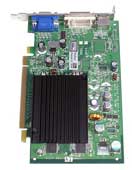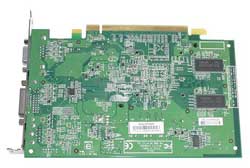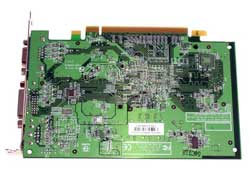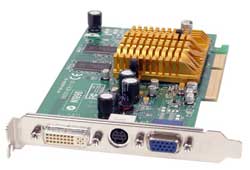Buyer's Guide - Entry Level to Mid-Range, March 2005
by Jarred Walton on March 15, 2005 1:30 PM EST- Posted in
- Guides
Video Cards
Assuming that you haven't selected one of the alternative motherboards with integrated graphics - or that you're looking for improved graphics performance - we have two different options. The socket 754 platform is currently AGP-only, although perhaps we'll see some PCIe boards using the nForce4 or a similar chipset in the future. The 939 and Intel platforms, on the other hand, are PCIe-only. (You could get a 939 AGP motherboard as well, of course.) The graphics recommendations will be different for each platform out of necessity, although we will try to keep price/performance as close as possible.AGP Graphics Recommendation:MSI Radeon 9550 128MB DDR 128-bit, 250/400 GPU/RAM clock (bulk/OEM)
Price: $67 shipped
For basic 3D graphics, the Radeon 9550 offers DirectX 9 support with enough performance to run most games that are two or three years old, and perhaps even more recent titles - at reduced quality levels. This is certainly no gamer card, but it does meet the minimum DX9 hardware requirement for the next version of Windows (Longhorn with eye candy enabled), and it will allow you to run either DVI or VGA displays along with providing TV-out support. There isn't a whole lot to differentiate the 9550 cards from one another, as they all run at similar clock speeds. We prefer the fanless varieties, of course, as they won't add any noise pollution to the room. If you can find some other brand for less money, it should be okay.
If you want more from your graphics, consider the GeForce 6200 AGP, 6600 AGP, and 6600GT AGP as the next three upgrades in order of performance. Their prices are around $100, $150, and $200 respectively, so you pay a lot more for the added performance. The Radeon 9600 (without the SE) is also a decent alternative that will only cost an extra $15. It's basically the same as the 9550 but with a faster core clockspeed (325MHz vs. 250MHz). For the price, we'd definitely stay away from the SE 9550 and 9600 cards.
 |
 |
| Click images to enlarge. | |
PCIe Graphics Recommendation: Leadtek GeForce 6200TC 64-bit, 64MB (256 shared) PCIe with 350 MHz core
Price: $71 shipped
If you missed our article on the new 6200 TurboCache cards from NVIDIA, now would be a good time to check it out. These are once again budget parts, but they manage to reduce price in an interesting way. With the added bandwidth of the PCI Express bus, the amount of graphics RAM on the cards can be reduced and system RAM can be used instead, all without seriously degrading performance. 16MB and 32MB versions can utilize up to 128MB of system RAM, and 64MB versions can use up to 256MB of system RAM. As with the 9550, the total performance level is still relatively low, but the 6200TC-32 is generally slightly faster than the 9600SE and X300SE while the 6200TC-64 is faster than the 9600/X300.
 |
 |
| Click images to enlarge. (Sample images of 16MB 16-bit 6200TC.) |
|
The TurboCache cards are available with either 32-bit or 64-bit memory interfaces, with core clock speeds ranging between 300 MHz and 350 MHz. The best price/performance is the 32MB 64-bit version, which is only slightly more expensive than the 16MB version. Look closely at what is being sold, however, as not all manufacturers or resellers are entirely clear on the specifications of the product being sold. If you can find some good pictures of the card, the presence of four RAM chips - two on each side - indicates that the card is a 64MB, 64-bit version. Two chips means that it's the 32MB, 32-bit model, and a single chip indicates that it's the low-end 16MB, 32-bit model. The full 128MB cards with 128-bit interfaces will have eight chips. To help you understand the differences, we have included two shots of the 6200TC-64 Leadtek card (front and back views) above. Compare that with the following images of a 6200TC-16 Leadtek card, and you can see the missing RAM chips.
PCIe Graphics Alternative:Leadtek GeForce 6600 128-bit, 128MB PCIe 300/550 MHz GPU/RAM
Price: $109 shipped
The full 6200 with 128-bit memory interface is the best of the "value" graphics chips, but with a price hovering just over $ 100, it's a pretty big jump. The better value at that range - at least for PCI Express - is to go with the 6600 chipset. It's supposed to be a "mid-range" part, and MSRP was initially $150, but the price has dropped quite a bit now. As most graphics chips are bandwidth limited with these cards, the jump from a 64-bit interface to a 128-bit interface improves performance quite a lot, particularly as resolutions increase. (If you're going with an AGP configuration, 6600 cards cost quite a bit more, so the 6200 128-bit is the better pick.) Overall performance of the 128-bit cards is generally better than the 9600 Pro cards of previous Guides, although not by a huge margin.
It is interesting to note that the current street prices on all the 6200 cards are quite a bit lower than the original estimates that we received from NVIDIA. The upgrade from the 16MB to 32MB cards is virtually free, with even the 64MB cards costing less than the original 6200 128MB cards. That's a good thing in our book, especially considering that the original 128-bit 6200 card is still the fastest of the bunch. For further performance increases, you'll need to look to the 6600 and 6600GT cards, just like on the AGP platform. If the X800 cards from ATI start to hit the $199 MSRP, that would also be a great option, albeit firmly in the mid-range price segment.
Update: Thanks to the reader comments for reminding us that the 9550 128-bit is a better choice than the 9600SE. The decreased GPU speed is typically less important than the increased memory bandwidth at this price point. They also pointed out the price drop on the 6600 PCIe cards, making them a better selection than the 6200 as an alternative. However, we still like the Gigabyte 6200 card initially listed as the alternative recommendation due to the inclusion of component output. If gaming isn't a concern but component output is, you might want to go with that instead of the 6600.












59 Comments
View All Comments
JarredWalton - Wednesday, March 16, 2005 - link
38 - I changed to the 9550 after the earlier corrections, as I had a 9600SE initially. I'll fix the text to suggest the purchase of a fanless 9550 and make the 9600 reference more appropriate. Thanks.doganti - Wednesday, March 16, 2005 - link
The article reads:"AGP Graphics Recommendation:MSI Radeon 9550 128MB DDR 128-bit, 250/400 GPU/RAM clock (bulk/OEM)
..
There isn't a whole lot to differentiate the 9550 cards from one another, as they are all fanless.."
I have Asus A9550 GE - Radeon 9550,128MB DDR,128 Bit and it has a fan (which has turned bad=noisy in a month).
Thus, also this is not clear: ".... The Radeon 9600 (without the SE) is also a decent alternative that will only cost an extra $15, and with it, you bump the memory bus up to 128-bits."
JarredWalton - Wednesday, March 16, 2005 - link
31 - If you can afford the bump to Athlon 64 3000+, the MSI RS480M2-IL would definitely be my pick for a board with IGP. Unfortunately, that adds $75 for the CPU upgrade (relative to the Sempron 2600+), but it also improves performance a decent amount. The ATI Xpress 200 is currently the best (BY FAR!) IGP on the market. It gives you S-VIDEO as well as VGA out. Too bad it doesn't have a DVI port as well. :)If that's too much... well, there are a lot of NF2 IGP boards for under $70. The NF2 is probably the better IGP between that and the K8M800 chipset, but the socket 754 CPUs are generally faster. With the price differences between platforms, I'd probably shoot for the Sempron 3000+ on socket A if you go for that platform. (The Barton core is simply the better choice, IMO.) That would compare relatively well with the socket 754 Sempron 2800+ - win some, lose some in benchmarks. I guess it really doesn't matter *too* much if you're not looking for the best performance possible. $150 gets you a decent CPU and mobo for socket A of socket 754, while on socket 939 it only gets you a CPU.
----------------------------------------
For the other comments, the PDP isn't great for overclocking, but with a price now at $130 and 2-3-2-5 timings, I'd take the GB of RAM even at stock speeds. If it OCs decently, great. If it doesn't, you should still be fine at stock speeds.
The Hitachi drives may not have the best RMA process, but let's be honest: if you need to use the RMA on *any* hard drive, you'll be very unhappy. I don't think any of the 7200 drives would fail in most systems if they're the only HDD. Just don't put a bunch of them next to each other without proper cooling. At $60 for an 80GB drive, I would probably make backups and if the HDD failed I'd buy a new drive while I RMA'ed the old one. That's just me, though.
Finally, the motherboard area is just such a hard one to give *one* recommendation. Even a recommendation and alternative doesn't really do justice to the available parts. There are so many good boards these days that are all within close proximity in terms of price. If I were looking for socket 939 boards, I'd go as follows in terms of chipsets:
nForce 4 (preferrably not 4X, but any are good)
ATI Xpress 200 (not many available yet)
VIA K8T890
nForce 3 Ultra
VIA K8T800 Pro
ALi/ULi/SiS whatever
I'd go with the top three over the bottom three by a pretty significant margin. K8T800 Pro is now about 9 months old, IIRC. It's still okay, but I wouldn't look to save money by going that route. The nF3 is the same, but it's the better chipset for AGP, IMO. Given the price the K8T800 Pro usually wins out, however.
Messudieh - Wednesday, March 16, 2005 - link
I have the PDP RAM that you mentioned in your review, and I can honestly say that the ability to overclock any one set is sort of a crap shoot it seems. It sounds to me like they use a couple of different types of chips (some being the TCCD chips, while others Infineon) that can all run at the stated 2-3-2-5 speeds, at 2.6 volts in my case.I think I got a set of something other than TCCDs, because I can't overclock them past about 210 with ANY timings on a DFI NF4 ultra-D with a watercooled 939 3000 and keep it stable, even at 3.1 or 3.2 volts.
Like I said...it's a crap shoot; some people get lucky, and others don't. I'm getting this RAM:
http://www.newegg.com/app/ViewProductDesc.asp?desc...
And selling my Patriot to my friend, who doesn't overclock.
Jep4444 - Wednesday, March 16, 2005 - link
oops forgot that the MSI board is 939, either way the Winchester based Athlons are good overclockers anywaysBPB - Wednesday, March 16, 2005 - link
"Semprons K8s are typically very good overclockers so i wouldn't rule out that noones is going to overclock them in a budget machine"Do they make socket 939 Semrpons?
As for me, I went with the MSI ATi based board and am very happy. Put in a 939 3000+, and a Hitachi 80GB SATA II drive. The Hitachi was only $62 at ZipZoonFly. So for a tad more got SATA II (I know, no SATA II controller on this board, but at least the drive has it). The board also has slightly better than average onboard sound, going with the Realtek ALC658C, not the 650 or 655 found in other boards.
Eventually will put a capture card and mid-level video card. I now have a pretty fast system for the price. Oh, went with the 1GB PDP Patriot memory in the article. No problems to report with anything. Very, very happy with the setup.
Jep4444 - Wednesday, March 16, 2005 - link
"The only downside is that the MSI's uATX board doesn't have any OC capability, but who's looking for that in a budget-minded PC?"Semprons K8s are typically very good overclockers so i wouldn't rule out that noones is going to overclock them in a budget machine
razor2025 - Wednesday, March 16, 2005 - link
Why no mention of MSI Neo4-F? It's less than the Chaintech @ $95 shipped at ZZF and it has same PCB as the Neo4 Platinum. That's much better choice over the Chaintech if you're going NF4 route. I also belive that the Xpress200 chipset should've been included as alternative. It's the perfect board for budget PC and it'll allow LOTS of options for upgrades later down the road. The only downside is that the MSI's uATX board doesn't have any OC capability, but who's looking for that in a budget-minded PC?If AMD can get a Sempron out for Socket 939 for around $100... then we can have some really nice sub $400-500 PC with lots of options for upgrade.
jxtramd - Wednesday, March 16, 2005 - link
OK I've followed the budget guide now for about 6 months and I'm on the cusp of a decision about building an AMD IGP based system. The choices are either from the Jan 05 guide with the MSI (or other) MB with the nForce2 IGP or the Mar 05 Chaintech (or other) MB with the VIA K8M800 IGP. Both systems with an appropiate Sempron 2600 and 512 memory. Between the two which combo gives the better graphics performance? I'm not interested in gaming. Just a basic system with the ability to capture video and watch DVD's as examples. A IGP system fits my budget - any comments?Jep4444 - Wednesday, March 16, 2005 - link
A little look on newegg has shown that every 32-bit 6200TC has 16MB of onboard RAM, oddly enough their are NO 32MB 6200TCs on newegg at all(whether 32 or 64-bit)also i looked at the review you guys posted on the 6200TC and here's a little bit of info on the 16MB and 32MB parts
"With NVIDIA talking about bringing the new 32MB 64-bit TurboCache part out at $99 and the 16MB 32-bit part out at $79"